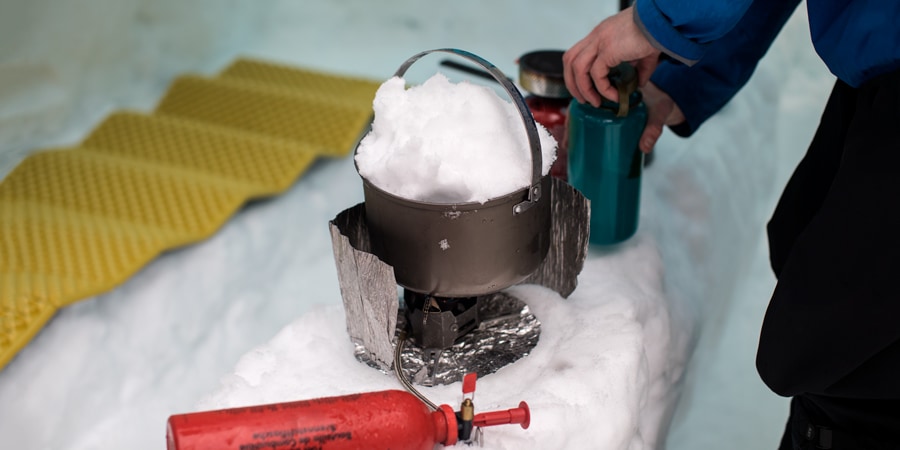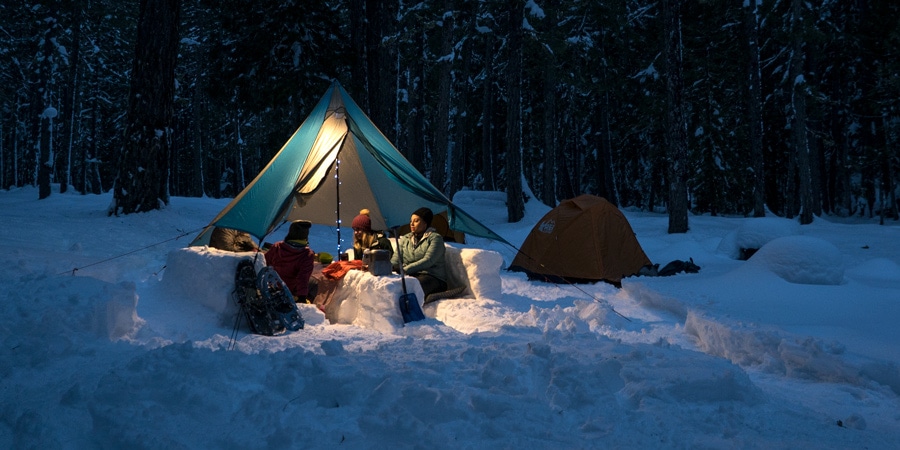A low rumble down the valley rattles me awake—it’s not loud nor physically jarring from where I’m camped on the West Fork of Alaska’s Ruth Glacier, but the distant avalanche is still deep, guttural and impressive. I sit up just enough to remove my sleeping bag’s hood from my ears, and that little bit of movement is enough to send down a shower of ice crystals from the tent ceiling. This is what happens when camping in the cold.
Winter camping in cold climates demands more effort and planning compared to a warm-weather overnight. But that challenge is what I love about it. Moving through the snow requires specialized gear, and your backpack is almost always far heavier than it would be for a similar summer trip. The cold saps your energy, and the fight to keep from getting wet is critical and anxiety-inducing. Your food freezes. You must thaw ice or snow for water.
During a summer backpacking trip, you might enjoy some legitimate downtime. But during the winter, there’s always something to do: digging tent platforms, melting snow for hot drinks and meals, adjusting layers, burrowing out after storms and so much more.
When I emerge from my tent to start the day’s chores, the air is biting. I zip into my cocoon of layers and slide my socked feet into stiff boots that froze solid overnight. I waddle through the packed powder to a pit my companions and I dug to protect our stove from the wind. I scoop a couple handfuls and melt it on the burner for tea. While I wait, I scan the desolate plain upon which our tent is the only blemish.

A cold-weather adventure offers a different kind of beauty. There are no lush landscapes here. The glacier is stark and clean, flanked by the steel-gray cliffs on either side. Everything sparkles in the still air. It’s a scene you don’t get during a crowded summer backpacking trip.
The water is boiling now. I pull off my mittens to reveal lighter wool gloves, which make it easier to work with the stove but provide enough insulation to keep my fingers warm. No need to open my jacket to fish out lighter ones. Efficiency is key in a place like this. Constantly tweaking gear and systems is necessary to keep as comfortable as possible out here, and I’ve grown fond of that challenge. It’s like a game, thinking through how I can efficiently use my socks to keep my feet as dry as possible, or how I can build a wall around the tent to keep the wind at bay, or deciding what I can afford to leave outside the tent versus what needs to come inside. In a lot of ways, being out here can feel unnatural for me, but the challenge of overcoming that is something I crave.
Of course, most creatures have deserted this winter landscape, leaving little to disturb the glacier’s acoustics. Backpacking almost anywhere is probably quieter than most peoples’ daily lives, but this is especially true in the Alaska Range. The snow’s crystalline structure creates tiny air pockets that absorb sound in the same way an igloo insulates its inhabitants. Everything is muffled and still. The early morning avalanche that woke me is probably five or six miles away, but as the one break in the quiet, it was enough to rouse me awake.
Now, the silence is so noticeable it’s almost a sound in its own right. I pour the water into my mug, already cradling a tea bag, and set it down momentarily so I can slip my hands back into my mittens. The sun is just cresting the low pass at the head of the glacier, streaming orange and yellow light down on my camp at the bottom of the canyon. The granite is starting to enjoy some color and I’m beginning to see the contours of the snowfield as sun and shadow mix.
No, it wasn’t easy to be able to enjoy this. But maybe that’s the point.
